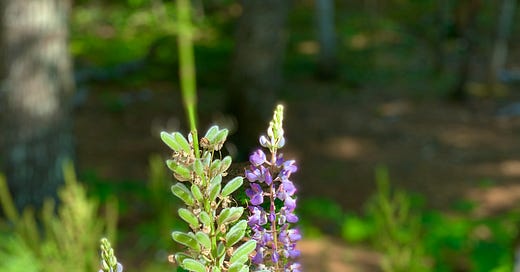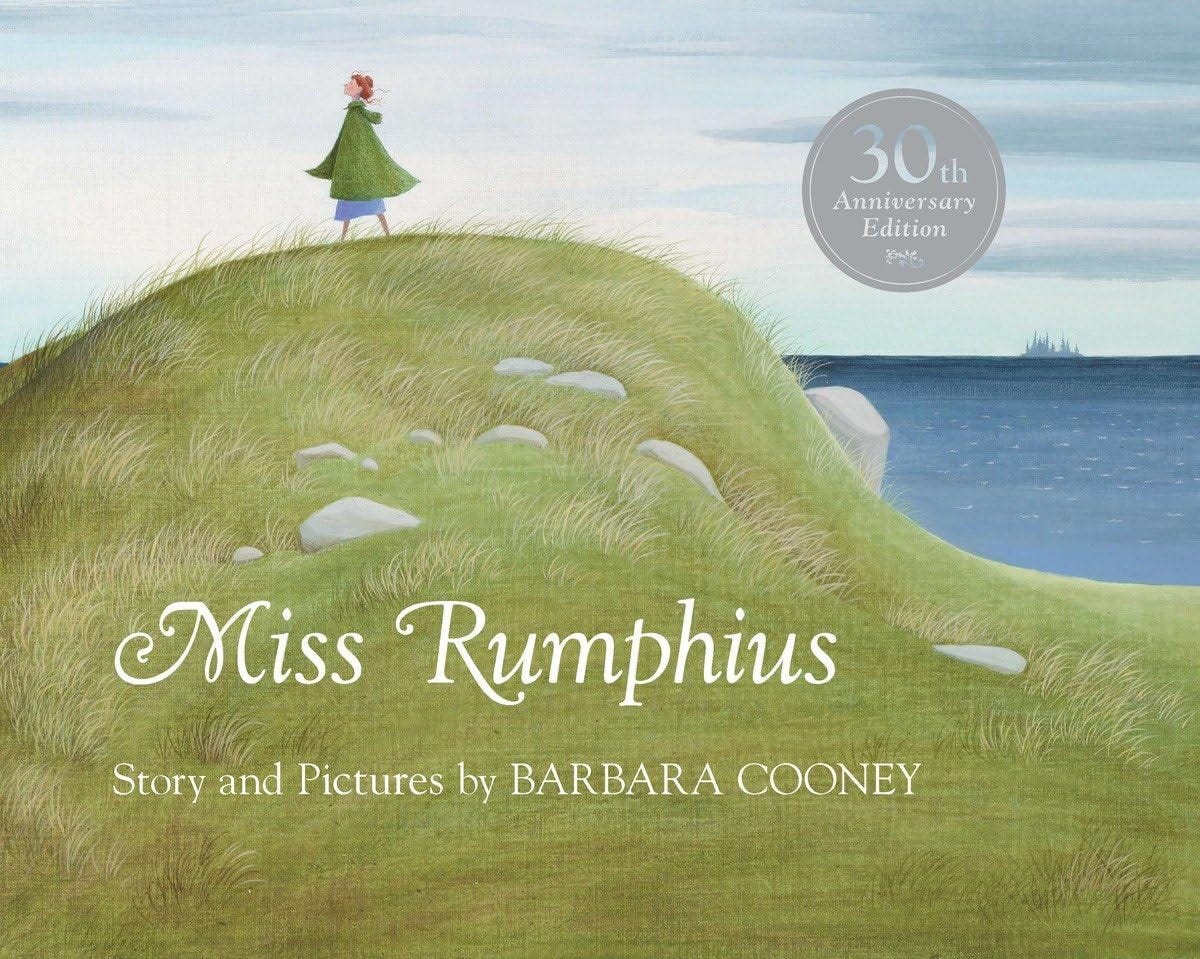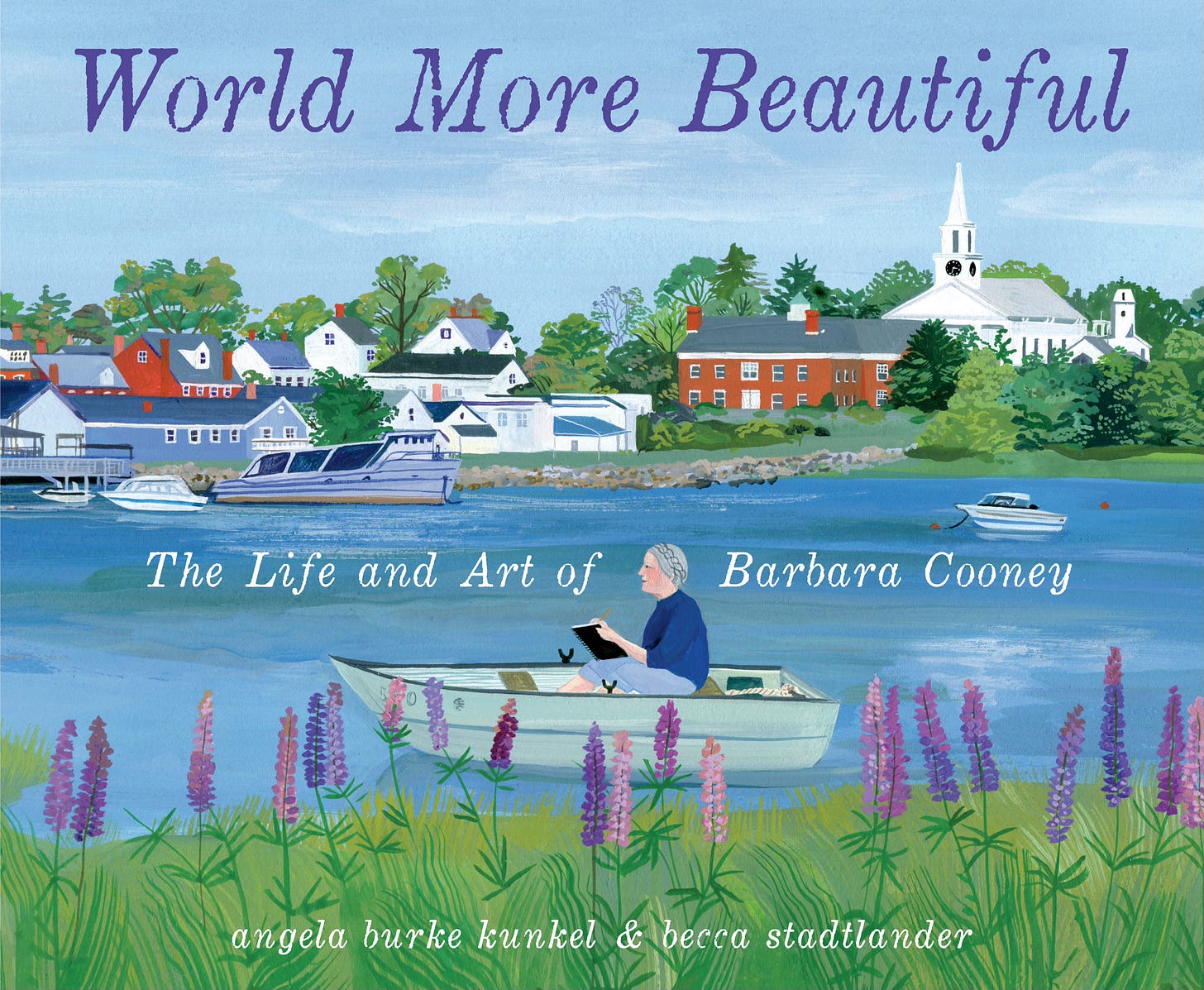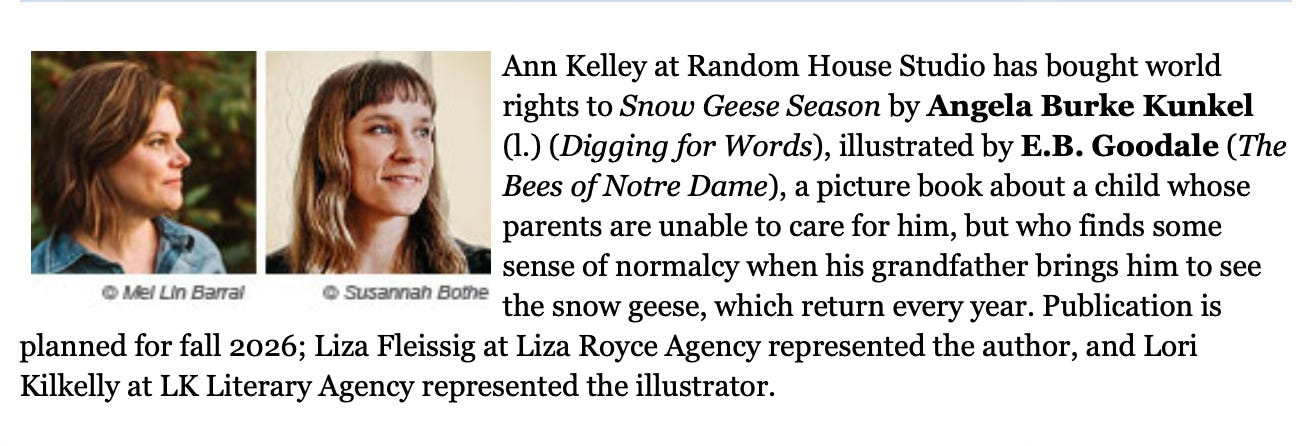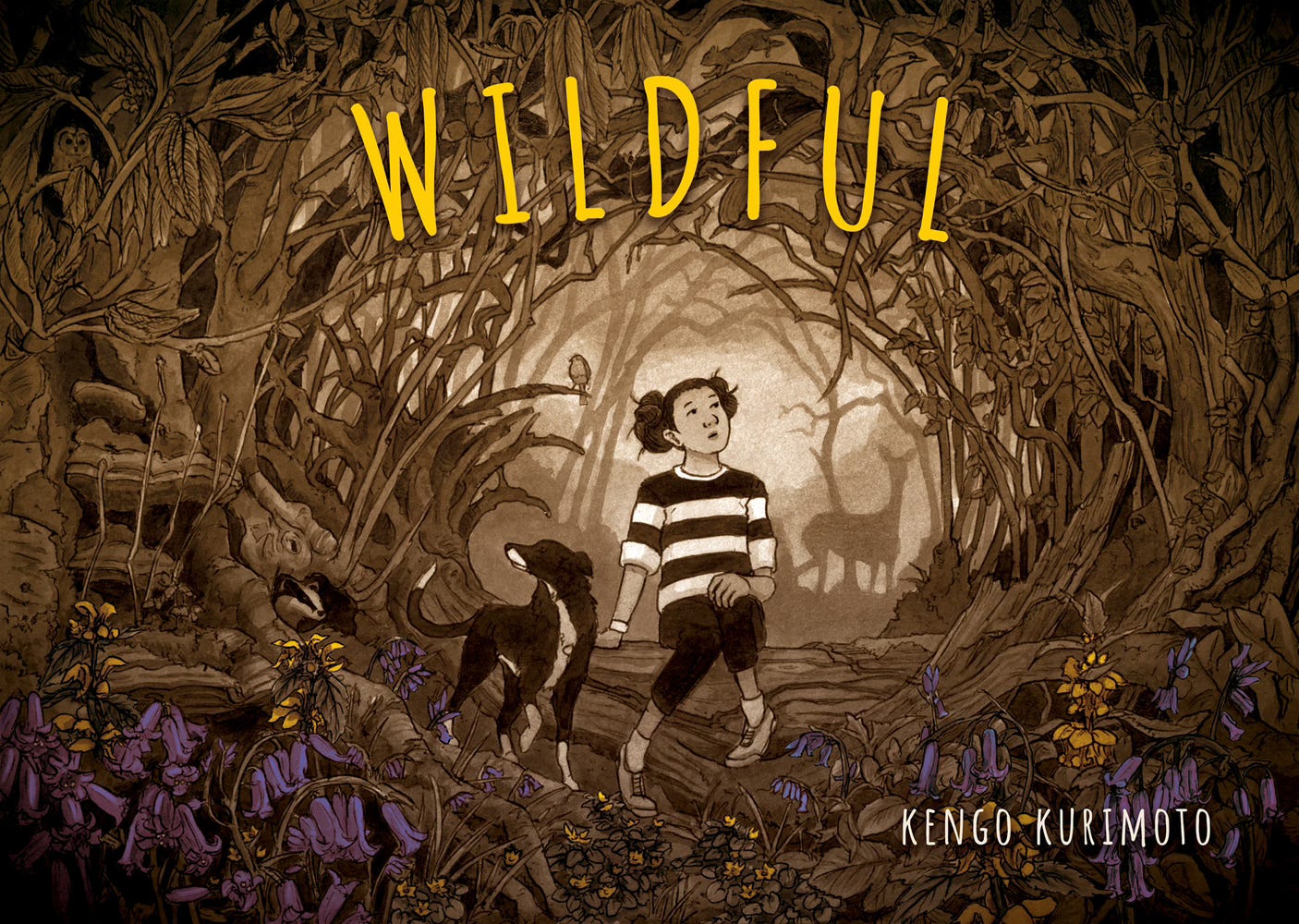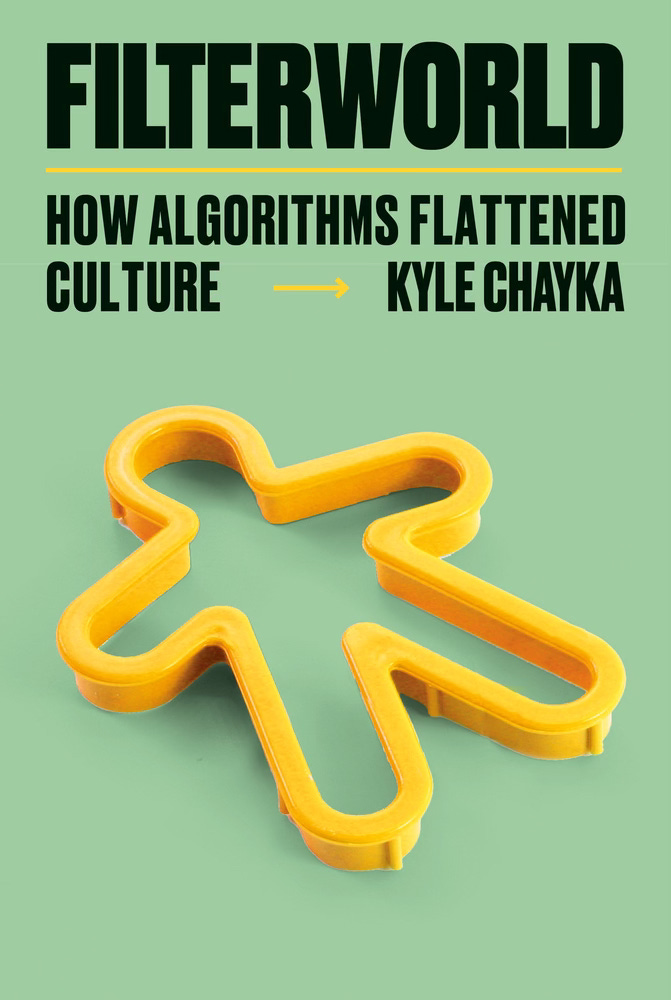So far in our Barbara Cooney series, we’ve explored her start in scratchboard, creative lessons from her Caldecott-winning book Chanticleer and the Fox, her many extensive travels, and how she looked closer to home for her second Caldecott book, Ox-Cart Man.
But my first introduction to Cooney was through Miss Rumphius.
I can still remember encountering this book for the first time, sitting cross-legged on the rug in the school library, while our librarian, Ms. Kautzman, read it aloud to us. I remember leaning forward to look closer.
I remember taking the book home and poring over the pictures.
And then I grew up. Miss Rumphius and I parted ways for awhile, until my daughter was born. My aunt sent me a stack of picture books as a gift, Miss Rumphius among them, and I read the story again as an adult and as a mother, and experienced the book anew. And then my daughter grew, too, and started reading independently, and the book sat quietly on the shelf once more. The pull, the return, the rediscovery—- my relationship to Alice Rumphius felt cyclical, that I grew and understood different things the book was trying to say at different stages in my life.
“After a hard winter, spring came.” These words from Miss Rumphius echoed in my head as I started work on my biography of Cooney during the pandemic of 2020-2021. I thought about Alice Rumphius and her world travels, and then how she was forced to be at home. It reminded me of the period of social isolation we were all going through— looking back on things we couldn’t do, and looking forward to when we’d be able to do them again. In what ways could the world still be beautiful?
When I was younger, I loved Miss Rumphius for its rich illustrations depicting a bygone era and a woman traveling the globe. The scenes with an elderly Miss Rumphius reminded me a little bit of moments with own my grandmother (who never traveled very far at all). I loved to sit and listen to her stories, imagining both her past and what the future might hold for me.
When I rediscovered Miss Rumphius as an adult, the book revealed new layers of meaning— what it means to be a woman in the world, what it means to be independent, what it means to lead a quiet but fulfilling life, what it means to leave a legacy.
Perhaps Barbara Cooney discovered these layers as she wrote, too— both in Miss Rumphius itself and throughout her long and prolific career. What strikes me now about Cooney is her persistence, over the course of years and years, in creating the artistic life she wanted for herself. She persisted in black and white until she was able to work in full color, she traveled the world to capture its beauty accurately in her illustrations, she pushed herself to experiment in different mediums.
As Barbara Cooney’s travels slowed, she entered a period of self-reflection, turning back towards her beloved Maine and reflecting on her own life (you’ll notice, on the cover of Miss Rumphius and in some of the interior illustrations, that Miss Rumphius moves from right to left. Typically, characters in picture books move left to right, but an aging Alice Rumphius is literally looking back). Cooney considered Miss Rumphius, Island Boy, and Hattie and the Wild Waves a trilogy, stating that they “come as close to an autobiography as I will ever get.”1
A little more next month on this intensely personal set of books in Cooney’s long career.
Praise for World More Beautiful
For her portrait of the beloved two-time Caldecott medalist, award-winning picture-book biographer Kunkel chooses a spare, poetic style; her lyrical language is as simple and yet as evocative as Cooney’s distinctive use of color. Reserving specifics about the artist’s life and accomplishments for her comprehensive afterword, Kunkel focuses instead on the development of the artist’s vision: how Cooney chose to follow her own muse, drawing inspiration from small daily moments and enlightening travel experiences deeply observed. In jewel-hued, richly detailed spreads and vignettes, Stadtlander’s charming, stylized art beautifully evokes the nuanced magic of Cooney’s resonant style. Concluding with a poignant note by Cooney’s son, this compelling profile is a perfect companion for readers discovering the works of this inspired storyteller who followed her own path and always did something to make it more beautiful. —Booklist
World More Beautiful comes out August 6th, on what would have been Barbara Cooney’s 107th birthday. If you’d like to pre-order a copy, you can do so from any major retailer or your local independent bookstore, and you can also request it from your local public library.
Upcoming Events for World More Beautiful
Wednesday, August 7th: Barbara Cooney Birthday Tea Celebration, 11:00 at Lawrence Memorial Library, Pepperell, MA
Saturday, August 10th: Storytime and craft from 10:30-11:30 AM at Lawrence Memorial Library, Bristol, VT
Saturday, August 17th: Storytime and craft at 10:00 AM at Inklings Children's Books, Waitsfield, VT
Sunday, August 18th: Storytime at 2:00 PM at the Northshire Bookstore, Manchester, VT
Monday, August 19th: Monday Morning Storytime from 10:00-11:00 AM at The Bookstore Plus in Lake Placid, NY
Saturday, September 7th: Bath Book Bash, 11:00 AM to 4:00 PM, Bath, ME
And . . . More Book News!
I am thrilled to share that I get to make a book with the talented
. Snow Geese Season really is a book of my heart— I’m lucky enough to live near their migratory path and started driving out to watch the geese during the pandemic (and have gone every year since). Their arrival and departure is a beautiful thing to witness.Random Good Things
Hokusai keeps showing up for me (I first wrote about it here), and I came across yet another layer— this article on Hokusai’s development as an artist and how The Great Wave changed over time and as his skill grew.
I loved this Maggie Rogers interview on NPR, particularly how she described her synesthesia and and her process of creating color mood boards for her music, and the importance of format and structure within play.
This conversation between
and Cal Newport. I love the idea of slow productvity and creative “seasonality,” especially as the school year comes to a close and I look forward to summer.Speaking of seasonality! This rhubarb crisp recipe from the New York Times is really good.
Books I’ve Read and Loved Recently
Wildful is an almost-wordless graphic novel about awe and attention and the ability to connect with nature. It was the perfect read, as we transition into summer, a time when I go on a social media hiatus and camp in the woods.
I also just finished Filterworld, by Kyle Chaka, which is really cementing why it’s become so important (for me) to take breaks from social media. In algorithmic feeds, such as Instagram, or TikTok, or Spotify, the experience is being chosen for you. As Chaka writes, “the more automated an algorithmic feed is, the more passive it makes us as consumers, and the less need we feel to build a collection, to preserve what matters to us.”
I want to be a creator, and not just a consumer. I want to spend the next few weeks slowing down, thinking about what matters, and what I want to make next. In terms of seasonality, I need to regularly unplug in order to reconnect with myself. And so I’m looking forward to summer, where I’ll be online less and outside more.
*Please note that all books mentioned above contain affiliate links to Bookshop.org, a site that helps support local independent bookstores.
Cooney, Barbara. “Voices of the Creators: Barbara Cooney.” Children’s Books and Their Creators, edited by Anita Silvey. Houghton Mifflin, 1995, p.166.

